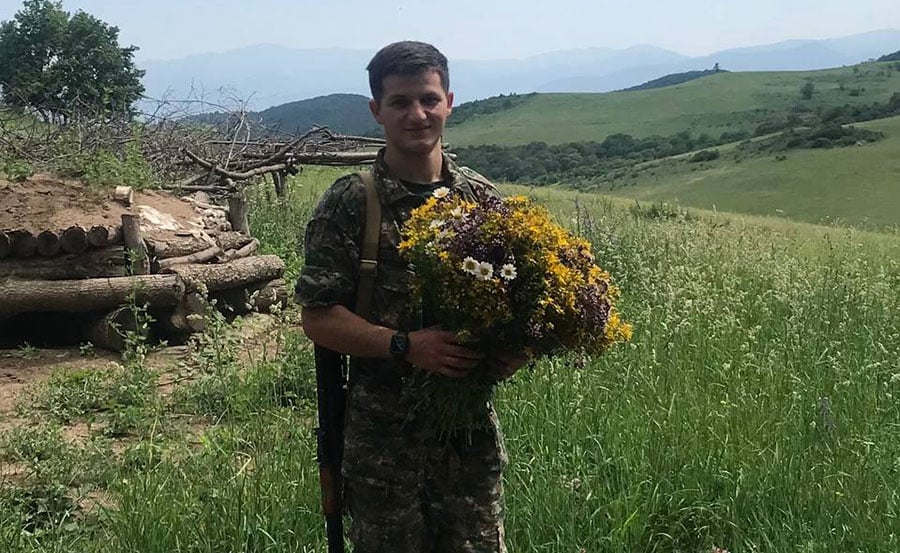by Anna Harutyunyan
Rudik Voskanyan, a former resident of Mets Tagher village in the Hadrut region of Artsakh, is a future doctor. While living in Artsakh under the 10-month blockade, he used his knowledge of folk medicine to help hundreds of people with the plants he collected. With the end of the blockade and the ethnic cleansing of Artsakh in September 2023, he now studies at the Armenian Medical Institute in Yerevan, where he recently organized a plant exhibition with the assistance of professors, showcasing the plants he brought from Artsakh to Armenia. I spoke with Voskanyan about his interest in folk medicine since childhood and bringing Artsakh’s native nature to Armenia.
Love of nature from childhood
Read also
My mother, a nurse, used to host biology study sessions at our house for students aiming for university. I also took part in the lessons. At first, I just listened to what my mother told me. Then, I felt that I remembered everything. I began to answer my mother’s questions myself. I was interested in biology and human anatomy. Around the age of six or seven, I knew the human structure. I decided to become a doctor when I was a child.
At a young age, I was interested not only in biology, but also in my surroundings and the flora. My grandfather is an agriculturist by profession. With him, I began to study, know and love nature. He also practiced folk medicine. Residents of both the village and neighboring regions sought his assistance. The best time to pick plants is in the morning. My grandfather and I used to go to the field in the morning. He was working, and I was studying plants. When I found an interesting, unfamiliar plant, I brought it and showed it to him.
First steps, first exhibition
I studied until the ninth grade in Mets Tagher, at the school named after Armenak Khanperyants. I finished high school in Yerevan at the “Shirakatsi Seminary” international scientific and educational complex. This decision was important to me, because I was away from my family and started to become more independent.
In 2019, my first exhibition was held at the seminary, where I presented herbariums containing about 60 types of medicinal plants. These plants are the last remaining memories and relics from Artsakh. Sometimes I go to the seminary and I see my plants posted on the wall, which are very well kept. They tell me that these plants even have a museum value, because they contain a great history.
In 2021, I graduated from school, entered the Armenian Medical Institute and was immediately included in the ranks of the Armenian Army, entering the service in Artsakh. During that time, my interest in my native land and the natural world did not decrease. I used to find and collect plants in the area during different seasons. Especially during the blockade, when the pharmacies ran out of medicines, plants helped my compatriots. In the final six months of my service as an army medic, certain herbs I gathered also assisted my fellow soldiers.
After 44 days of war, my family moved to Yerevan. It so happened that during the war I was in Yerevan, and they were in Artsakh, and during the blockade I was in Artsakh, and they were in Yerevan.
The most important thing is human life
When I finished my service, due to the blockade, I could not come to Armenia right away. I stayed in Stepanakert. In order not to waste time, I decided to work as an intern at the Republican Medical Center of Stepanakert. When there was a shortage of fuel and many doctors could not come to work from afar, I helped the staff. Sometimes I was on duty at the hospital.
When I was a child, I wanted to become a military doctor, but now I have yet to choose a final specialization. When I was in Artsakh, a wounded soldier was brought to a hospital, where there were no conditions to provide assistance. They were taken to the hospital, where the patient was given final treatment. It doesn’t matter whether you are a military or a civilian doctor; in both cases, the most important thing is human life.
On August 24, facilitated by Russian peacekeepers, students from Artsakh were relocated to Goris and Yerevan to pursue higher education. I was also with them. Now I study in the first year. Recently, a second exhibition of my plants was organized at the university, the idea of which arose from an essay assigned by a chemistry professor. When they divided topics, I asked if I could choose a topic of my choice. After a positive answer, I prepared a work on Artsakh plants. My lecturer liked it very much. The abstract was presented to the dean’s office, and it was decided to organize this exhibition. It is very important for me to arouse interest among my fellow students and other students in our native nature and folk medicine. In my opinion, we will achieve greater results by combining scientific and folk medicine.
The loss of Artsakh and a new beginning
The war, the blockade and the depopulation of Artsakh were very hard for me. I have not only lost my place of residence, but also my relatives and friends. There was a time when I didn’t even want to study; I felt broken.
Then I started to think that suffering and bad thoughts are only harming us. A successful and mature society is the key to the development of every country, where every person is responsible for their profession and other people. I started to work on my way of thinking and realized that we only need to look forward. Everything that happened to us should be the basis for us to return to Artsakh even stronger in the future. The loss of Artsakh marked the beginning of a new history filled with revenge and struggle.




















































